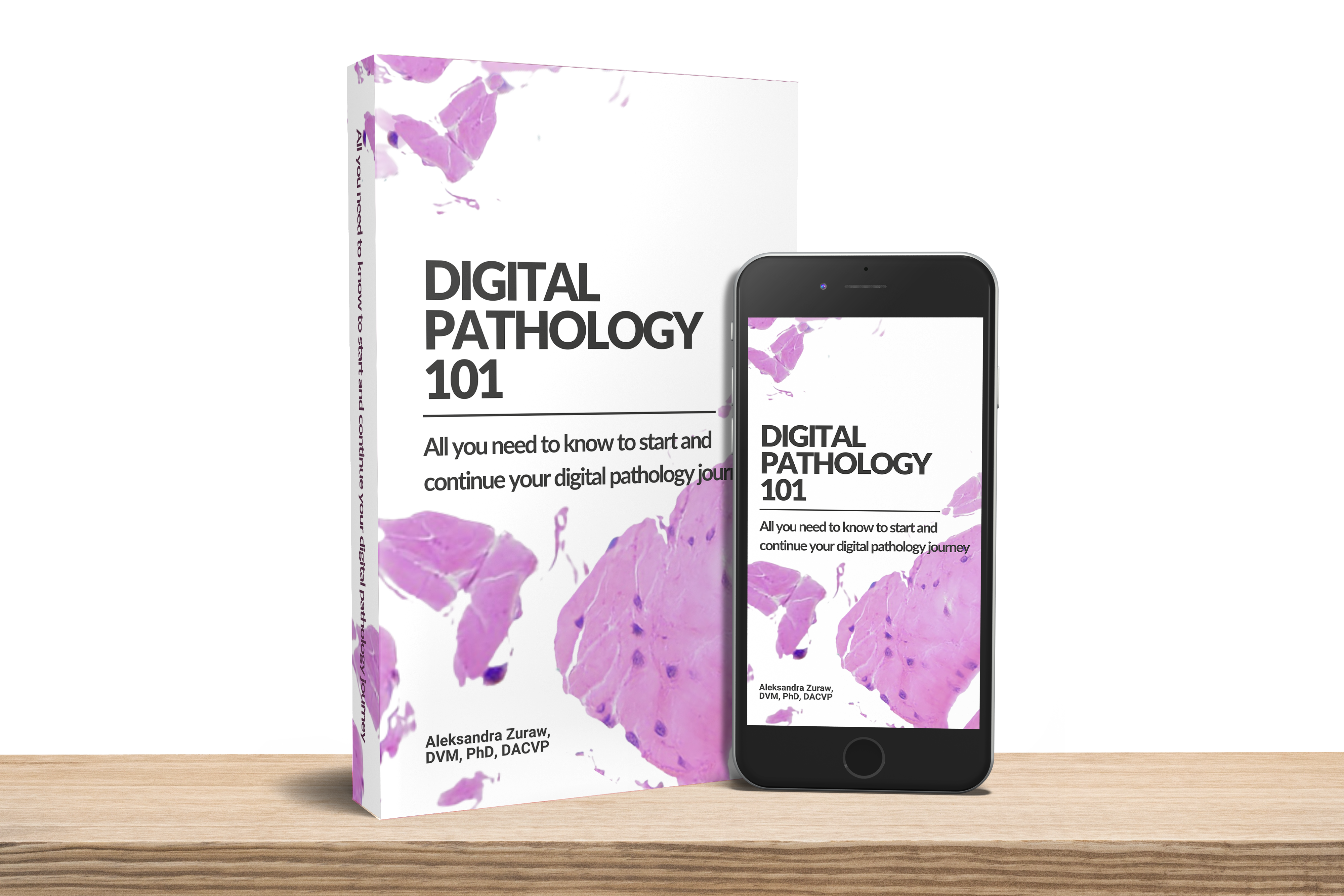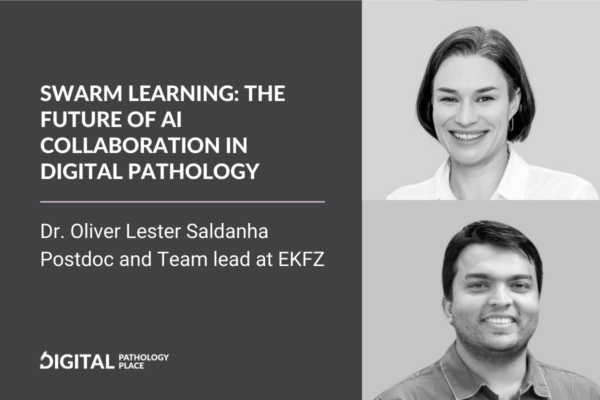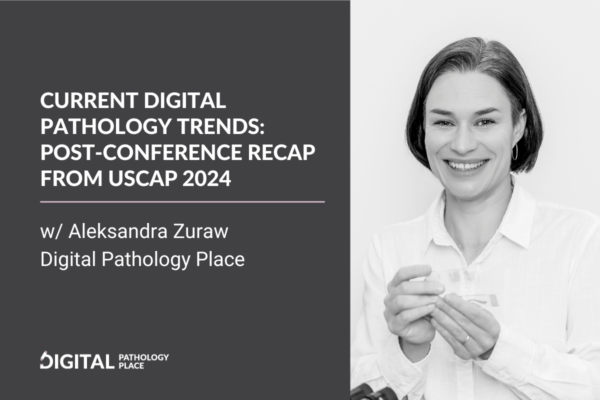Aleksandra Zuraw: [00:01:09] Today my guest is Regan Baird from Visiopharm and this is part one of our three part series about multiplex stains. In this first episode, we are going to talk about the introduction to multiplex for tissue image analysis.
[00:01:26] Hi Regan, how are you?
Regan Baird: [00:01:28] I’m doing well. Thanks, Aleks.
Aleksandra: [00:01:30] Thank you so much for joining me today. Welcome to the podcast. Let’s start with introducing yourself to the listeners. Tell them a little bit about yourself and about your background and obviously what led you on the digital pathology?
Regan: [00:01:44] Sure. Yeah. So, my name is Regan Baird. I’m the regional manager for the Eastern territory of North America for Visiopharm.
[00:01:53] I started my scientific career. I got a PhD in biochemistry at temple university in Philadelphia. From there. I went on to do a postdoc at the Beth Israel Deaconess Medical Center in Boston, where I started learning four dimensional, live animal imaging, doing some really cool [00:02:09] things with microscopes. And of course, a lot of image analysis that went along with that.
[00:02:14] And slowly I got my I wound up in digital pathology for Visiopharm because I really enjoyed the image analysis side.
Aleksandra: [00:02:20] So you did different imaging modalities, more dimensional image analysis. Did you experience a lot of difference with switching to tissue?
Regan: [00:02:29] Oh, absolutely. When you’re dealing with 4D high speed, making three dimensional pictures rotate. You have all this really cool technology and big, expensive equipment. And you look at histology slides, and from that perspective, they seem relatively simplistic. But now that I’ve had to get into image analysis and artificial intelligence to handle analyzing these tissues samples.
[00:02:54] Oh my goodness. They’re so hard to be able to get a computer to figure out what things are going on in there. It’s getting easier. It’s getting better, but I always marvel at how pathologists can just look at those pieces of tissue and see what’s going on instantly. Obviously, they’ve had a lot of training as well.
Aleksandra: [00:03:09] We did indeed. But yeah, you say it’s difficult for image analysis and that’s why maybe you can use multiplex staining to make it a little bit easier. When I think about a multiplex, my first thing that comes to my mind is going to be immunofluorescence, maybe immunohistochemistry with multiple colors, and let’s start with telling the listeners, what is multiplex?
Regan: [00:03:34] Sure. I think every field comes up with multiplex in, and basically, it’s a term that you’d use to describe how you can make multiple measurements at the same time. And in histology, really, we’re thinking about the ability to look at multiple biomarkers on the same piece of tissue at the same time.
[00:03:52] We’re also starting to see the incorporation of genetic markers in these multiplex assays as well.
Aleksandra: [00:03:57] I mentioned the IF, bright field chromogenic with several colors. What are other modalities for multiplexing?
Regan: [00:04:07] Sure. Yeah. There’s a lot of ways of being [00:04:09] able to generate a multiplex with tissue slides today. The easiest one I think, is just to do the normal IHC or chromogenic stains that we’re used to using in histology, and then being able to do that across serial sections.
[00:04:24] So you can have differentially stained, serial sections and stack them using co-registration techniques to create a virtual multiplex. And then that concept can go into IF or bright field chromogenic assays. Then what people have started doing now is being able to use that same concept but do it on the same piece of tissue where you do cyclic rounds of staining, imaging, washing, staining, imaging, washing to create a multiplex on the same piece of tissue.
[00:04:53] Of course, there’s many more, the rainbow of colors that are available in chromogenic space is starting to increase too. And so, we are seeing up to about five different chromogenic colors on the same piece of tissue. Immunofluorescence is nice because with immunofluorescence, you’re not [00:05:09] taking a single image. In chromogenic assays once the colors start overlapping, you don’t know how much contribution you’re getting from one or the other, but in immunofluorescence, you know exactly how much staining contributes to any given cell in the image.
[00:05:23] The immunofluorescence still has some limitations due to the way that the microscopes or the scanners take pictures.
[00:05:29] And so there’s some techniques called spectral unmixing that can be used to remove a lot of the background or crosstalk that can happen in immunofluorescence. And the spectral unmixing techniques gets you to about nine different biomarkers on the same piece of tissue.
[00:05:45] And then the newest technology is actually using imaging mass cytometry, using time of flight cytometry, where they’re able to using heavy metals rather than, chromogens or fluorochromes to be able to monitor up to 60 biomarkers on the same piece of tissue at the same time. Each has its own advantages. Each has its own limitations, and each comes at a different price point.
Aleksandra: [00:06:07] Considering that [00:06:09] practical and also the quality and the number of markers that we would be able to visualize, which modality would be best suited for tissue image analysis, and why.
Regan: [00:06:21] They’re all well-suited, as I said, they each have their advantage. They each have their disadvantage.
[00:06:25] If you’re doing a low plex, several times, you can get ideal staining conditions for each biomarker, but tissue is precious and maybe you want to be able to do all of your bio markers at the same time. I would suggest that whichever modality you’re working with or you’re choosing. It really is best to carefully plan the experiment and plan the assay’s so that you can get the results that you’re looking for, rather than just dumping a whole bunch of biomarkers on a piece of tissue and hoping you can interpret the results.
Aleksandra: [00:06:54] You touched a little bit on advantages and disadvantages of IF versus bright field multiplexing. Maybe we can elaborate on that a little bit more.
Regan: [00:07:04] Yeah. Sure. So, in a chromogen really, you’re taking a [00:07:09] single picture of the tissue with the color cameras on the scanners. And as those chromogens start to overlap and co-localize on a cell, they’re going to start, they’re going to change colors.
[00:07:20] And most of the chromogen manufacturers recommend the most that you can really do is two, co-localizing biomarkers on a given cell. Just because as things get darker and darker, it’s hard to interpret which biomarkers those signals are coming from. In IF you’re able to get an individual picture for each of the biomarkers.
[00:07:44] So you really know the contribution of each biomarker to the cell. And so, you really can tease out how, what the relative biomarker expression levels are in the cell, regardless of how many overlap.
Aleksandra: [00:07:56] What can be multiplex used for? It is a technology that enables us to visualize multiple biomarkers in the tissue, but what would be the [00:08:09] applications at the moment?
Regan: [00:08:10] Sure. I think that the main reason for doing multiplex is so you can start phenotyping all of the individual cells in the tissue, and really the advantage of being able to do it in tissue, as opposed to other flow cytometry techniques is because you can actually see the spatial relationship and the context of which the cells are participating in that tissue.
[00:08:34] So the real purpose is to phenotype every single cell in the tissue so that you can look at not only what biomarkers a particular cell is expressing, but what their neighbors are doing and really to do some new analysis terms like spatial -omix or studying the interactome of different cells and the environment which they live.
Aleksandra: [00:08:59] Thank you so much for giving us this introduction to multiplex and thank you for being my guest.
Regan: [00:09:05] Oh, my pleasure. It was fun. Thank you, Aleks.
Aleksandra: [00:09:07] And have a great day.
Regan: [00:09:09] You too.















